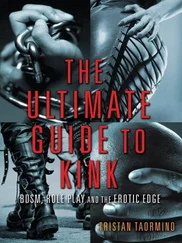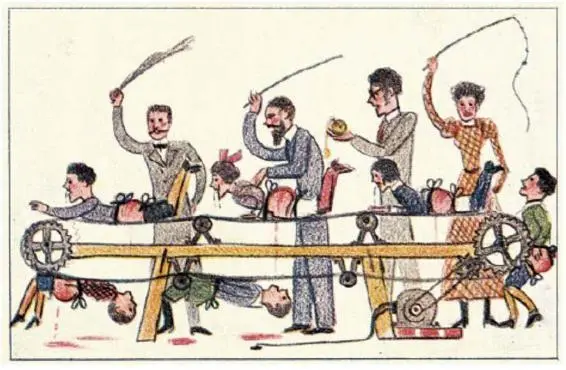
Fantasy drawing of a 12-year-old masochist
Mostly what visitors remembered from Hirschfeld’s Institute were the museum exhibits displayed in the “Gallery of Derangements of the Sexual Instinct.” Hanging from ceiling hooks were wooden boards that illustrated Hirschfeld’s case studies. The multitudinous sexual personae of his Sexual Intermediaries were disclosed in arresting photographic series. Glass cases of fetishistic objects and sex aids from preliterate, Asian, and European cultures filled two other rooms. In the open counters and boxes were collections of Mandigo dildos that squirted a milky solution, Moché water bottles with penis-shaped spouts, Sanskrit sex manuals, miniature shoes worn by bound-foot Chinese courtesans, medieval chastity belts, torture instruments from a German brothel, sadistic drawings and assemblages created by Lustmord convicts, an entire picture window of ankle boots donated by a local fetishist, antique steam-driven vibrators, fake rubber breasts and vaginas taken from transvestite prostitutes, lacy panties found on the corpses of von Hindenburg’s heroic officers, and other such incontrovertible evidence of Hirschfeld’s new calculus of desire. There were also free-standing sex machines and masturbation devices of every shape and variety.
Eisenstein especially enjoyed the Institute’s collection of sailor-dolls—homemade paper toys that German homosexuals fashioned during the Great War. The figures were drawn naked, except for their caps and boots, and designed to show off the marines’ aroused genitals and smiling faces. Tiny red paint drops were splattered over the blithe forms to give the incongruous appearance of deadly wounds. After bringing them out of their case, a delighted Papa asked Eisenstein and his friends if they carried any penknives in their pockets. When the entourage failed to turn up any, Hirschfeld explained the reason for his inquiry: homosexuals rarely packed them.
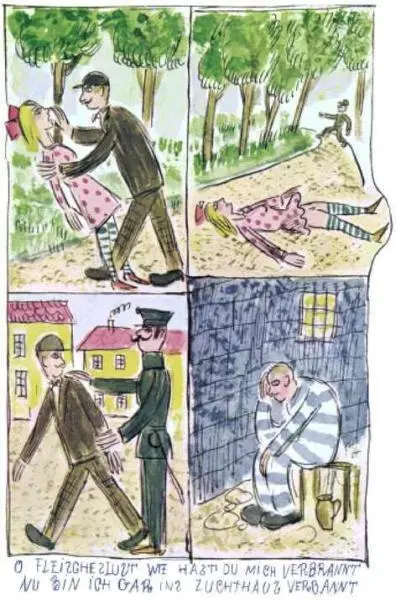
Therapeutic drawing of an imprisoned rapist
Hirschfeld employed Sexual Intermediaries for his museum docents and assistants. “Herr Alfred” was a slim, fortyish Bavarian peasant woman, the mother of one child with a normal het sex interest. Her only abnormality was wanting to live in the clothing of a man. The Institute hired her along with two dozen other inside-the-spectrum types. André Gide almost bolted from the Institute when Papa had a “Sexual Intermediate: Grade Three” employee unbutton his shirt and reveal two perfectly-shaped female breasts.
How Hirschfeld’s Institute of Sex Science paid for its huge staff and many house expenses remained a carefully guarded secret. Only a fraction of the Berlin patients compensated the Institute for their immense needs. The city chipped in here and there, but never enough to keep the place running at full throttle. Rumors abounded that German gay magnates channeled funds in sealed envelopes or that a famous Ruhr industrialist, known to be a closeted infantilist, forked over a fortune to Hirschfeld for the construction of a private nursery, laden with sex apparatuses in the shape of old toys.

Life-size sex dolls
More likely, Hirschfeld used his own inheritance to support the Institute. He also formulated and patented several heavy-duty aphrodisiacs and Viagra-like anti-impotence tablets. The best known of these was called Testifortan, a concoction of yohimbé bark from French West Africa and clamshell from the North Atlantic. Hirschfeld advertised that Testifortan stimulated the centers of hormonal production, chemically charged the synapses of the nervous system (especially those along the spine), and regulated the restricted blood flow into the male genitals through dilation and engorgement of the corpora cavernosa .
Testifortan and Hirschfeld’s “Titus Pills” were marketed in Galante magazines, at German pharmacies, and in the Museum gift shop, where visitors could purchase other enhancers, Sittengeschichten , and an array of scientifically-tested sex remedies. The Nazi and Allied-installed German governments thought highly enough of Hirschfeld’s patented compounds to claim his formulas for themselves and sell the licensing rights to Swiss pharmaceutical firms. They were a source of state revenue for German health ministries until 1962.
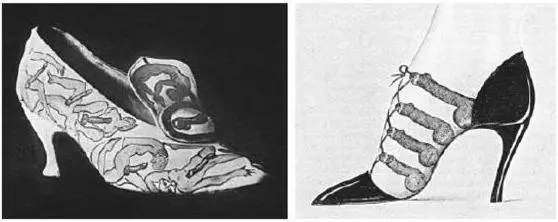
Homemade “Penis Shoes”
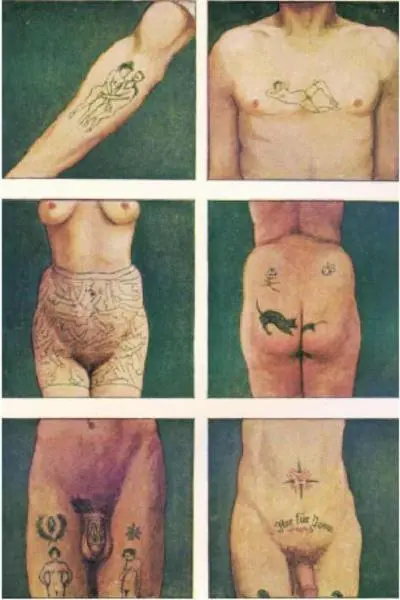
Erotic tattoos of sailors and criminals
Hirschfeld’s outsized personality and quasi-scientific proclamations drew an endless stream of critics. Some ranted against Sexology as a legitimate science. Others, like the homophobic Dr. Albert Moll, questioned Papa’s objectivity and found ingenious methods to blunt Hirschfeld’s international standing. He usually accomplished this by denying the doctor’s medical credentials at world congresses. Freud, whom Hirschfeld adored, avoided the entire topic of endocrine-based sexology despite the hearsay belief that he received a sexual rejuvenation operation at Hirschfeld’s Institute in 1922.
The renegade Freudian, Wilhelm Reich, transferred his clinical base from Vienna to Berlin in 1930. A fervent Communist, anxious to establish an Institute for Sexual Politics (Sex-Pol), Reich mocked Hirschfeld’s egalitarian attitudes toward sexual morality. Good orgasmic sex, according to Reichian doctrine, was always uninhibitedly straight and the result of vigorous genital thrust. Intermediary erotic desire, like the capitalist system itself, was not immutable nor a natural aspect of human character. Homosexuality and other such perversions demanded a healthy revolutionary response, curative techniques that the Marxist Viennese claimed to pioneer. Hirschfeld’s sexual nihilism, however well-intended, Reich harangued, was furthering fascism.
Of course, the Nazis did not see it that way; they tried to murder Hirschfeld as early as 1923. And when Adolf Hitler came to power ten years later, the Institute of Sexology was one of his first targets. Much of the leadership of the Ernst Röhm’s Storm Troopers (the Nazi SA) covertly subscribed to Brand’s Militant Homosexualism and feared that among Hirschfeld’s Questionnaires were sexual profiles that might ultimately embarrass them. The liquidation of the Institute and its archives was doubly important for Röhm.
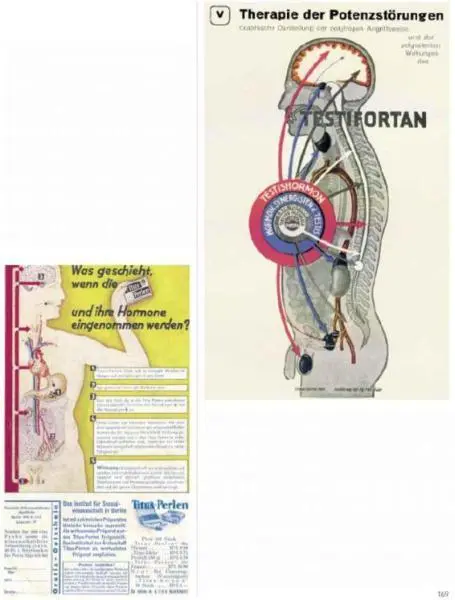
Magazine advertisements for Hirschfeld’s Titus Pills and Testifortan
Hirschfeld lived for two more years outside Germany. He scurried around Europe in hopes of rekindling his career and Institute but knew his base of power could only reside in Weimar Berlin, a spiritual metropolis that had been excised from the map by National Socialism. In 1935, on his 65th birthday, Magnus Hirschfeld, the fighter for sexual science and understanding, died a lonely death during his exile in the South of France.■
Читать дальше









